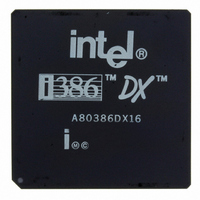A80386DX16 Intel, A80386DX16 Datasheet - Page 32

A80386DX16
Manufacturer Part Number
A80386DX16
Description
IC MPU 32-BIT 5V 16MHZ 132-PGA
Manufacturer
Intel
Datasheet
1.A80386DX16.pdf
(139 pages)
Specifications of A80386DX16
Processor Type
386DX
Features
32-bit
Speed
16MHz
Voltage
5V
Mounting Type
Surface Mount
Package / Case
132-PGA
Family Name
Intel386 DX
Device Core Size
32b
Frequency (max)
16MHz
Supply Voltage 1 (typ)
5V
Operating Supply Voltage (max)
5.25V
Operating Supply Voltage (min)
4.75V
Operating Temp Range
0C to 85C
Operating Temperature Classification
Commercial
Mounting
Through Hole
Pin Count
132
Package Type
PGA
Lead Free Status / RoHS Status
Contains lead / RoHS non-compliant
Other names
807050
Available stocks
Company
Part Number
Manufacturer
Quantity
Price
Intel386
registers The Li bits are cleared by the processor
during a task switch to avoid spurious exceptions in
the new task Note that the breakpoints must be re-
enabled under software control
All Intel386 DX Gi bits are unaffected during a task
switch The Gi bits support breakpoints that are ac-
tive in all tasks executing in the system
2 12 3 3 DEBUG STATUS REGISTER (DR6)
A Debug Status Register DR6 shown in Figure 2-13
allows the exception 1 handler to easily determine
why it was invoked Note the exception 1 handler
can be invoked as a result of one of several events
1) DR0 Breakpoint fault trap
2) DR1 Breakpoint fault trap
3) DR2 Breakpoint fault trap
4) DR3 Breakpoint fault trap
5) Single-step (TF) trap
6) Task switch trap
7) Fault due to attempted debug register access
The Debug Status Register contains single-bit flags
for each of the possible events invoking exception 1
Note below that some of these events are faults (ex-
ception taken before the instruction is executed)
while other events are traps (exception taken after
the debug events occurred)
The flags in DR6 are set by the hardware but never
cleared by hardware Exception 1 handler software
should clear DR6 before returning to the user pro-
gram to avoid future confusion in identifying the
source of exception 1
The fields within the Debug Status Register DR6
are as follows
Bi (debug fault trap due to breakpoint 0– 3)
Four breakpoint indicator flags B0 – B3 correspond
one-to-one with the breakpoint registers in DR0 –
DR3 A flag Bi is set when the condition described
by DRi LENi and RWi occurs
If Gi or Li is set and if the ith breakpoint is detected
the processor will invoke the exception 1 handler
The exception is handled as a fault if an instruction
execution breakpoint occurred or as a trap if a data
breakpoint occurred
IMPORTANT NOTE A flag Bi is set whenever the
hardware detects a match condition on enabled
breakpoint i Whenever a match is detected on at
least one enabled breakpoint i the hardware imme-
32
when GD
TM
e
DX MICROPROCESSOR
1
diately sets all Bi bits corresponding to breakpoint
conditions matching at that instant whether enabled
or not Therefore the exception 1 handler may see
that multiple Bi bits are set but only set Bi bits corre-
sponding to enabled breakpoints (Li or Gi set) are
true indications of why the exception 1 handler was
invoked
BD (debug fault due to attempted register access
when GD bit set)
This bit is set if the exception 1 handler was invoked
due to an instruction attempting to read or write to
the debug registers when GD bit was set If such an
event occurs then the GD bit is automatically
cleared when the exception 1 handler is invoked
allowing handler access to the debug registers
BS (debug trap due to single-step)
This bit is set if the exception 1 handler was invoked
due to the TF bit in the flag register being set (for
single-stepping) See section 2 12 2
BT (debug trap due to task switch)
This bit is set if the exception 1 handler was invoked
due to a task switch occurring to a task having an
Intel386 DX TSS with the T bit set (See Figure
4-15a) Note the task switch into the new task oc-
curs normally but before the first instruction of the
task is executed the exception 1 handler is invoked
With respect to the task switch operation the opera-
tion is considered to be a trap
2 12 3 4 USE OF RESUME FLAG (RF) IN FLAG
The Resume Flag (RF) in the flag word can sup-
press an instruction execution breakpoint when the
exception 1 handler returns to a user program at a
user address which is also an instruction execution
breakpoint See section 2 3 3
3 REAL MODE ARCHITECTURE
3 1 REAL MODE INTRODUCTION
When the processor is reset or powered up it is ini-
tialized in Real Mode Real Mode has the same base
architecture as the 8086 but allows access to the
32-bit register set of the Intel386 DX The address-
ing mechanism memory size interrupt handling are
all identical to the Real Mode on the 80286
REGISTER












